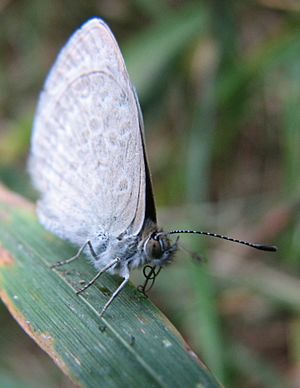Bathurst copper facts for kids
Quick facts for kids Bathurst copper |
|
|---|---|
 |
|
| Conservation status | |
| Scientific classification | |
| Kingdom: | |
| Phylum: | |
| Class: | |
| Order: | |
| Family: | |
| Genus: |
Paralucia
|
| Species: |
P. spinifera
|
| Binomial name | |
| Paralucia spinifera W.H. Edwards & Common, 1978
|
|
The Bathurst copper butterfly (also called the purple copper butterfly) is a special kind of butterfly. Its scientific name is Paralucia spinifera. It belongs to the Lycaenidae family, which includes many small, colorful butterflies. This butterfly is found only in Australia, meaning it's endemic there.
What Does It Look Like?
This butterfly has a body that is a bit thick. Its wings can spread out about 20 to 30 millimeters wide. That's about the size of a large coin!
When you see its top wings in the sunlight, they look copper-colored. They also shimmer with beautiful purple, blue, and green colors. The undersides of its wings are different. They have patterns of brown, black, and gray. The butterfly's antennae are black with tiny white spots. Each antenna ends with a black tip.
Where Does It Live?
The purple copper butterfly lives mostly in places that are high up. These areas are usually above 900 meters (about 3000 feet) above sea level.
They like spots that get sunlight all day long. Often, these places face west or north. The butterfly's home also gets very cold. It often has regular winter snow or heavy frosts. In these cold places, the butterfly feeds on a type of plant called blackthorn.
How Does It Grow?
Bathurst copper butterflies usually appear between August and November. If they live in higher, colder places, they might appear a bit later. Their busiest time is a two-week period in September.
After the butterflies mate, the female lays her eggs. She places them on or near a plant called Bursaria spinosa subsp. lasiophylla. When the eggs hatch, tiny larvae (caterpillars) come out. These larvae have a special relationship with a type of ant called A. itinerans. The ants protect the larvae from predators, like birds or other insects. In return, the larvae give the ants some special sugary liquids.
Why Is It Endangered?
The Bathurst copper butterfly is considered an endangered species. This means it is at a high risk of disappearing forever. In New South Wales (NSW), Australia, it is listed as endangered under the Threatened Species Conservation Act 1995. It is also listed as a vulnerable species across Australia under the Environment Protection and Biodiversity Conservation Act 1999.
Several things are threatening this special butterfly:
- Clearing and Development: When land is cleared for buildings or farms, the butterfly loses its home and food plants.
- Weed Invasion: Weeds can grow and take over the areas where the butterfly's food plants live.
- Grazing: Animals like cattle or sheep eating too much of the plants can harm the butterfly's habitat.
- Changes in Fire Management: How controlled burns (fires set on purpose to manage land) are done can also affect the butterfly's survival.
- Gimenez Dixon, M. 1996. Paralucia spinifera. 2006 IUCN Red List of Threatened Species. Downloaded on 31 July 2007.


